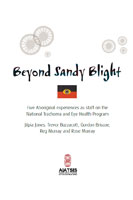Beyond sandy blight: five Aboriginal experiences as staff on the National Trachoma and Eye Health Program
Trachoma has been an enduring problem for Aboriginal Australians. Possibly the first mention of trachoma in Australia was made by the Englishman William Dampier who visited the coast of north-western Australia in 1688 and wrote in his diary, ‘They have great heads, round foreheads and great brows … their eyelids are always half-closed to keep the flies out of their eyes’ (Mann, 1966). A century later, the British invasion of the continent truly began with the establishment of the convict settlement at Sydney Cove in January 1788. Since then, trachoma has been recorded widely in Australia and has affected both whites and blacks.
The disease was endemic and related to the harsh and unhygienic living conditions which frequently led to serious eye disease and visual loss. The early white invaders called the disease ‘Sandy Blight’. Indeed, it is inscribed on various landscapes. In the Central Desert of the Northern Territory, there is a place called Sandy Blight Junction, and Ernest Giles, one of the early white explorers, called a range in the desert area of Western Australia, the Ophthalmia Ranges.
This publication documents insider accounts of the National Trachoma and Eye Health Program for rural Aboriginal (and non-Aboriginal) Australians, led by Fred Hollows during the 1970s.
